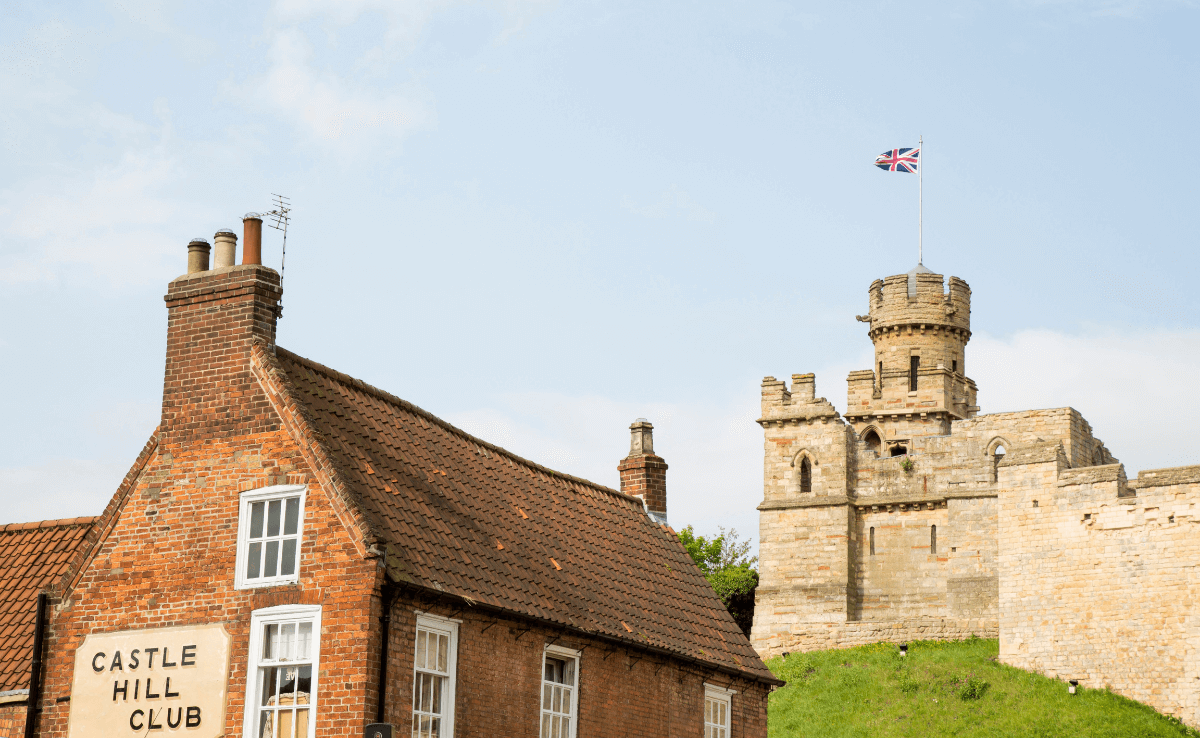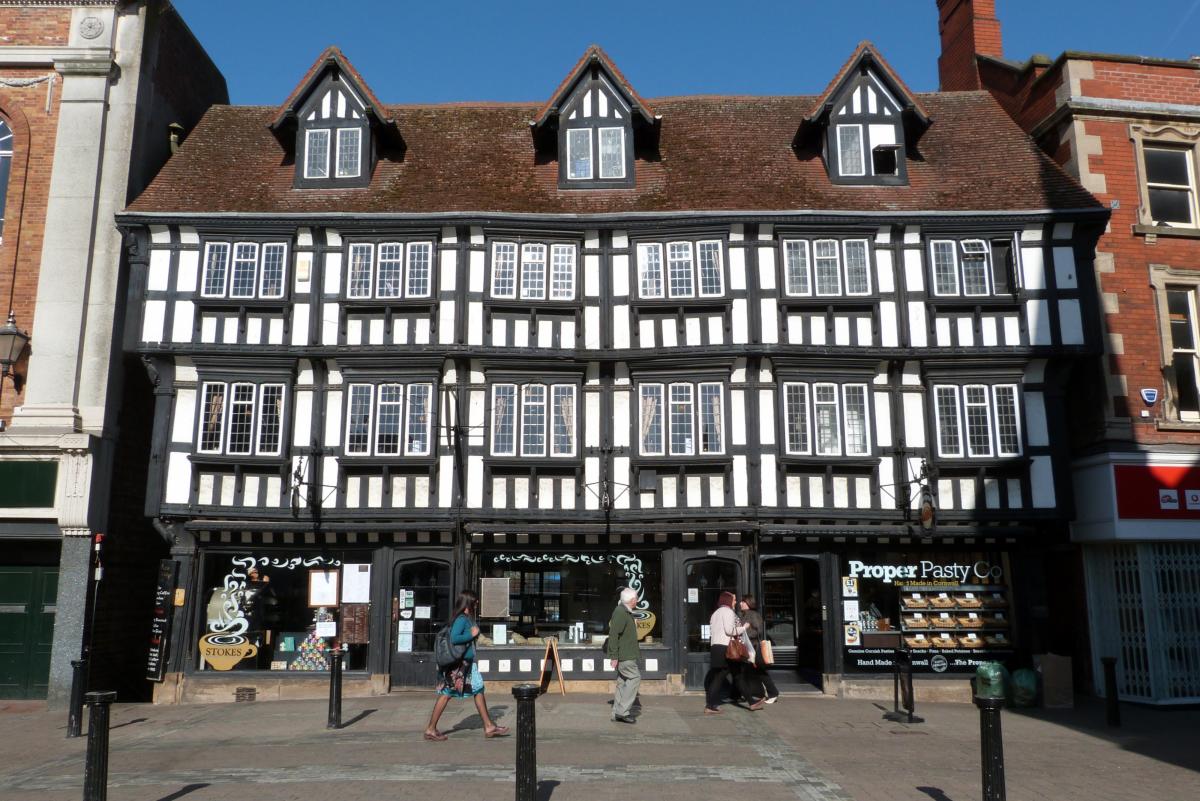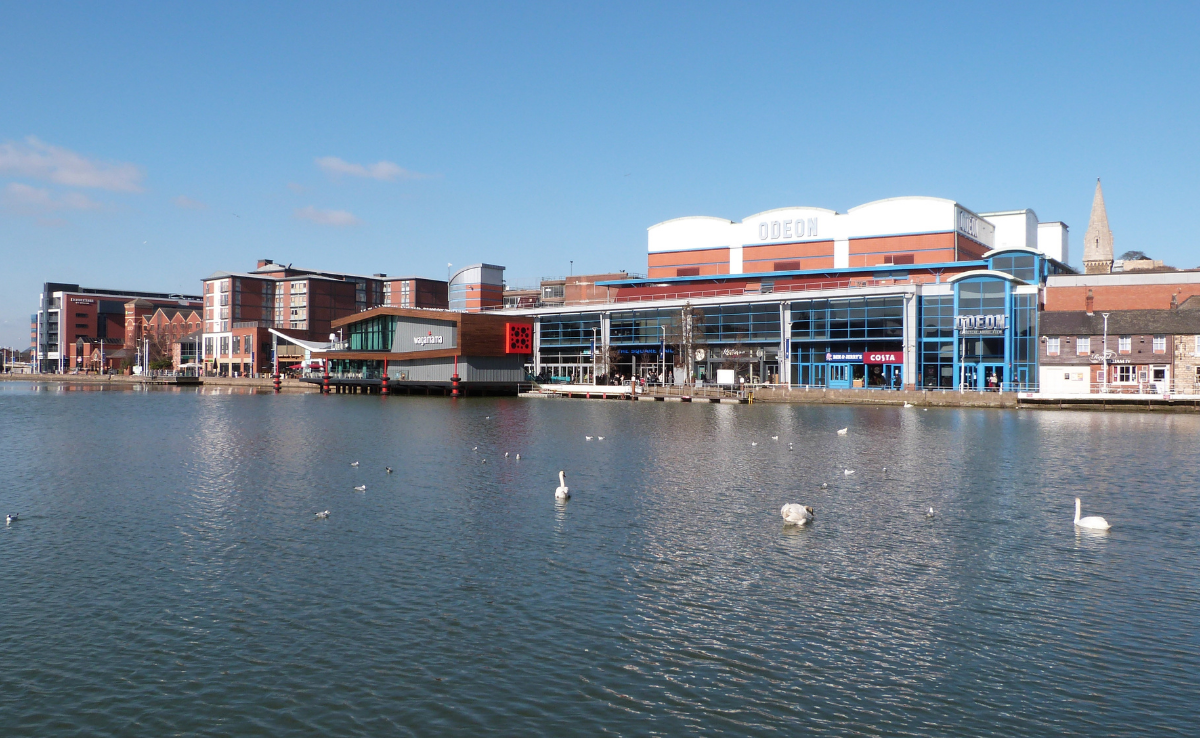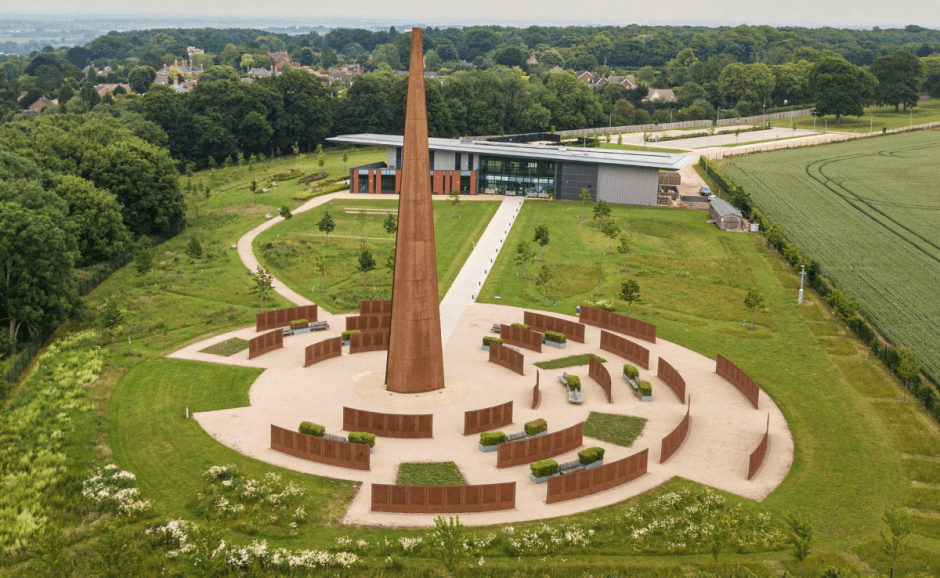Crowned as the UK’s most underrated city break, it’s fair to say Lincoln is home to a number of stunning sights. From the mischievous Lincoln Imp in the Cathedral to the Roman ruins beneath the High Street, we’ve listed the top 10 absolute must-sees in Lincoln.
1. Steep Hill & Bailgate
Steep Hill is a photographer’s dream! With an average incline of 16.12°, it is the fourth steepest hill in England. Once voted Britain’s Best Street, this picturesque, cobbled street is lined with quaint independent shops and restaurants.
Look out for the wonky lamp post half-way up Steep Hill, where you can catch your breath on the ‘Mayor’s Chair’. Just around the corner, you will also find the crooked house on Michaelgate, one of Lincoln’s most photographed spots. This iconic location is where the famous climb occurs during the Lincoln Grand Prix cycle race.
Continue up the hill and you will find the beautiful Bailgate. One of the most historic areas in the city, Bailgate is home to a variety of shops, pubs and eateries. Walk right to the end of the street and you will find Newport Arch, a Roman gateway constructed in AD200 (see below). You can spot evidence of Lincoln’s Roman beginnings throughout Bailgate, as this street is thought to follow the original Roman road that ran through the area.
A number of events in Lincoln take place around Bailgate, including the annual Steampunk Festival and the Christmas Market. Steep Hill and Bailgate are connected by Castle Square, where you will find monthly markets, selling everything from antique wares to local produce. No matter when you visit, there’s always something going on!
2. Lincoln Cathedral
Lincoln Cathedral is undoubtedly the most iconic building in the city. Built in 1072, the cathedral is one of the finest examples of Gothic architecture in all of Europe.
From 1311 - 1548, Lincoln Cathedral was the tallest building in the world. After surviving both a fire and an earthquake, the cathedral was rebuilt and the towers were capped with wooden spires, taking the height of the building to a staggering 525 feet. In 1548, a particularly fearsome storm caused the central spire to collapse, and it was never replaced. Although the other two spires remained intact, their weight caused the towers to lean significantly, and they were eventually removed in 1807.
Due to its impressive architecture, Lincoln Cathedral has formed the backdrop for a number of blockbuster movies. The Da Vinci Code, Young Victoria and Ridley Scott’s upcoming Napoleon biopic have all been filmed here.
- Lincoln Imp
Legend has it that the Lincoln Imp was a naughty little creature, causing havoc all around the Midlands. When he and his friends arrived at Lincoln Cathedral, he pushed his luck too far and was turned into stone by an angel. Look closely, and you will be able to spot the Lincoln Imp at the top of one of the Cathedral pillars.
- Cathedral Tours
There are a number of tours you can take around Lincoln Cathedral which will allow you to find out more about the building’s architecture and history. An introductory floor tour is included in your admission to the Cathedral. Ideal for first time visitors, an expert guide will take you on a journey through the building, revealing hundreds of years of history. If you’re interested in the cathedral’s inner workings, you can go behind the scenes on the Roof Tour. For those with a head for heights, the Tower Tour will take you all the way up to the top of the Central Tower, where you can experience the most amazing views across the Lincolnshire countryside.
- Dean’s Green
Outside the Cathedral, you will find the Dean’s Green. After being closed to the public for 40 years, this peaceful green space was renovated as a part of a National Lottery funded project. Reopened in 2020, the Dean’s Green has been beautifully landscaped with new lawns, flowerbeds, walkways and seating. It also offers a magnificent view of the North-side of the Cathedral, which until now hasn’t been fully visible.

3. Newport Arch
Situated at the top of Bailgate, Newport Arch dates back to the 3rd century. Constructed in AD200, this arch is part of the original north gate for the Upper Roman City of Lindum Colonia.
As Newport Arch was the north gate to the city, the road passing through this gateway was incredibly important, as it linked London to York. What we can see today is only the inner arch of the gateway, so the original structure would have been much taller – and potentially quite daunting to unwelcome visitors!
The outer arch is thought to have been demolished in 1790 and a considerable amount of the structure is also now hidden underground, as the road level has been raised over time. The arch has undergone plenty of restoration work throughout the years, some of which dates back to medieval times.
You can find more evidence of Lincoln’s Roman past throughout the city. If you’re keen to learn more, we recommend booking a place on the Roman Walking Tour. Free to attend, this award-winning guided tour offers a fascinating insight into Roman Lincoln.
4. Lincoln Castle
Lincoln Castle has dominated the city’s skyline for almost 1000 years. Built by William the Conqueror in 1068, the castle was once one of the most powerful strongholds in Medieval England. Visit today and you will get the chance to immerse yourself in history – and walk in the footsteps of kings and criminals.
To help you make the most of your visit, there are free guided tours on offer every day, which provide a fascinating insight into the castle’s somewhat gruesome past. You will get the chance to explore burial grounds, prisons and execution sites, and learn more about some of the city’s infamous battles.
Although you will need a ticket to go inside, the grounds of Lincoln Castle are free to visit. There is plenty to see outside, including an impressive statue of King George III. The grounds of Lincoln Castle also play host to a number of events throughout the year. Visitors can enjoy dog-friendly weekends, medieval re-enactments, live concerts and a number of festive events at Christmas.
Courts have been held at Lincoln Castle since it was first built, and Lincoln Crown Court is still situated within the grounds. If you want to pass some time, grab a coffee from the café and just try to imagine how many criminals must have passed through the gates here!
- Medieval Wall Walk
The great stone curtain wall is one of the boldest hallmarks of Lincoln Castle, and a permanent reminder of its role as a mighty medieval stronghold. You can walk the full circumference of the walls on the castle’s Medieval Wall Walk.
This amazing experience will take you on a journey through history, offering panoramic views across the beautiful city and countryside along the way; Head to the east wall battlements for the best viewpoint of Lincoln Cathedral!
- Magna Carta
You can see original copies of both the 1215 Magna Carta and the 1217 Charter of the Forest for yourself in Lincoln Castle’s subterranean David P J Ross Magna Carta Vault. Drawn up by English Barons, Magna Carta protected the principle that the king had to act within the rule of law, limiting his power. This iconic document protected the country from the tyrannical King John and changed the course of history forever. The original Magna Carta was rewritten in 1217, and the Charter of the Forest was issued as an accompanying document.
Lincoln Castle is the only place in the world where an original copy of both of these documents can be seen together, on permanent loan from Lincoln Cathedral. In addition to the atmospheric Magna Carta vault, there is also an underground cinema, where you can immerse yourself in the story of the Great Charter.

5. Lincoln’s Green Spaces
Lincoln is home to a number of parks and green spaces. The Arboretum, Liquorice Park and Temple Gardens are all within walking distance of the city centre, perfect for escaping the hustle and bustle of the high street.
The city also has two commons to explore, the West Common and the South Common. Both areas offer a huge expanse of open space, and amazing views of the Cathedral. Although you are just a short walk from the city centre, you’ll feel like you’re in the middle of the countryside.
On the outskirts of Lincoln, you will also find a number of larger parks, including Whisby Nature Park, Hartsholme Country Park and Boultham Park. Home to an abundance of wildlife, walking trails and picturesque views, these popular parks are well worth a visit – whatever the weather!
6. High Bridge
Situated in the centre of the High Street, Lincoln’s High Bridge was built over the River Witham in 1160. It is believed that there will have been a bridge on this site since Roman times, although the structure would’ve originally been made of wood, not stone.
It is quite likely that High Bridge in Lincoln is now one of the oldest standing bridges in the country; It is also the only medieval bridge in England to still have buildings on it.
During the Medieval and Tudor periods, it was common to have buildings on bridges, but very few remain today. The first structure to be built on the High Bridge was a chapel dedicated to Thomas Becket. This was removed in the 18th century and all that is left from the bridge’s original purposes is a short row of black and white timbered shops, which date back to around 1540.
These unique Tudor buildings are now home to Stokes Coffee, who have two cafes inside - Stokes High Bridge Cafe and Stokes to Go. With wooden beams, leaded windows and low ceilings, visiting Stokes is like stepping back in time. This iconic building is absolutely steeped in history, and it’s a real experience to go inside. Soak up the atmosphere with a cup of Stokes famous coffee - which is roasted right here in Lincoln.

7. Lincoln Guildhall & Stonebow
The Stonebow is situated in the centre of Lincoln High Street. This impressive stone arch was built on the site of a Roman gateway, known as Posterngate. The remains of the original Roman structure still lie underneath the city street, and are accessible from inside the building.
The original gateway remained in situ long after the Romans left the city. In 1237, the Guildhall moved into the building above the arch. This was used as a meeting place for the local governors of the city and a courtroom to hear local disputes.
When the original gatehouse became unsafe in the 13th century, the city was ordered to build a new structure by King Richard II. Unfortunately, the money for the build was embezzled and the project took over a hundred years to complete. Work on the new Stonebow and Guildhall was completed in 1520 – which is the building you can see today.
The interior of the Guildhall is even more spectacular than the exterior – and a real hidden gem. Most people walk under the arch, not realising what awaits above. The building is open to the public for free guided tours on Monday, Wednesday, Friday and Saturday. As well as hearing about the building’s chequered history, you will be able to see a huge collection of historic artefacts, paintings and regalia, including the sword of Richard II which was gifted to the city in 1387. The Guildhall treasury is believed to be one of the most important civic collections outside of London.
8. Brayford Waterfront
The Brayford Waterfront is one of Lincoln’s most picturesque areas. Offering a wide range of restaurants, bars and entertainment venues, this is a great place to soak up the city’s vibrant atmosphere. On a sunny day, alfresco dining here is a must - all of the restaurants offer excellent views across the water.
During the summer months, you can also hop aboard the Brayford Belle for a different perspective of the city. This guided boat tour will take you along the River Witham, offering entertaining commentary about Lincoln’s past and present. Alternatively, you can walk along the Fossdyke Canal Trail, which runs for approximately 6 miles, from Lincoln to Saxilby.
The Brayford is most famously home to the University of Lincoln. After gaining University status in 1992, Lincoln Uni is now placed among the top 20 universities in the UK for student satisfaction in both the Complete University Guide 2022 and the Guardian University Guide 2022.
The University’s Brayford Campus is also home to The Engine Shed, the largest live music and entertainment venue in the region. The Engine Shed has hosted a plethora of global superstars over the years, from Kasabian to Kings of Leon!

9. Museums & Galleries
Lincoln is home to a number of fantastic museums and galleries. Perfect for a fun family day out, there are exhibitions and experiences to suit all ages - and all interests. Spend a day at each one, or simply dip in and out on your way round the city. Most importantly, all of the museums here are free to visit!
- The Lincoln Museum
The Lincoln Museum is an award-winning archaeology museum located in the heart of the city. The museum has a fantastic range of permanent exhibitions, focusing on the history of Lincolnshire. Many of the displays here are interactive, making them enjoyable and accessible for all. The Lincoln Museum also hosts a variety of guest exhibitions throughout the year, alongside live talks, classes and events.
- The Usher Gallery
The Usher Gallery is Lincolnshire’s most prestigious art gallery. It houses a wonderful collection of fine art and contemporary paintings, including works by Turner, Lowry and DeWint. There is also an impressive array of porcelain, ceramics, glassware and jewellery on display. Similar to The Collection, The Usher Gallery also hosts an exciting annual programme of temporary exhibitions.
- The Museum of Lincolnshire Life
The Museum of Lincolnshire Life is located on Burton Road, just a short walk from Lincoln Castle. This fantastic museum focuses on all aspects of life in Lincolnshire, from 1750 to present day. Permanent exhibitions here showcase and celebrate the county’s heritage, from industry and military, to domestic and community life. There are some fantastic artefacts here, including a World War I tank and a Victorian printing press.
10. International Bomber Command Centre
Opened in 2015, the IBCC is a memorial to mark the service and sacrifice of World War II aircrew, ground crew and support staff that lost their lives whilst serving with Bomber Command.
At the heart of the IBCC sit the Memorial Spire and the Walls of Names. The spire is 102ft - the same height as the wingspan of a Lancaster bomber. If you walk through the spire, the view leads you directly to Lincoln Cathedral; the same view that informed the Bomber Command unit that they were almost back from their missions. For those who failed to return to Lincolnshire, this was their last view of home.
The Wall of Names surrounding the spire remember almost 58,000 men and women who lost their lives serving or supporting Bomber Command during World War II. The IBCC is the only place in the world where all of these people are commemorated.
There are also two Peace Gardens outside the IBCC, offering a quiet space to relax and reflect. The Lincolnshire Peace Garden includes 27 native trees, marking each of the operational stations in the county. The International Peace Garden pays homage to the 62 nations who served or supported the service.
After you’ve explored the grounds, head inside to the Chadwick Centre to visit the exhibition space. Using state-of-the-art technology and interactive displays, this moving experience tells the story of Bomber Command. There are interviews with eyewitnesses, veterans and survivors, all of which offer a fascinating insight into the history of the service.
If you’re planning a trip to Lincoln, you may also be interested in:

